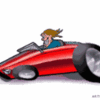John,
The short answer to your question is that it is "close" but not enough.
I want to use this opportunity to give a soap box lecture. It's not aimed at you John, so please don't feel singled out.
I have often run into resistance regarding the setting of the "initial advance" on the distributor. People are "afraid" to set it anywhere other than the factory setting, or a setting they read in a magazine, or a setting some mechanic has given them.
I have run into performace engine builders, guys who are intelligent enough to port cylinder heads & grind cams, that have told me " I set all my engines at 12 degrees, it works for me". Crap! LOL.......... These guys accept the fact that engines of different states of tune require different cams, different gearing, different carburetors, different carburetor jetting, even different centrifugal advance calibration, but for some reason know only to them, all engines use the same initial advance setting, doesn't matter if its a Ford or a Chevy, a small block or a big block, an RV cam or a solid lifter cammed dragster. Does that make sense to anybody reading this?
I think the problem is, the best vacuum method of setting the initial advance has never been published in a performance book or magazine. They always give a magic "number". It seems the authors of this literature never ran across the same old coots I did as a youngster. This method for setting initial advance is not my idea, I learned it long ago from old greasy mechanics who learned their trade before Hot Rod magazine existed.
Think of this: "Total advance" can only be determined on a dyno, under load. But no car is under load at idle, so initial advance can easily be determined in the driveway, using the "best vacuum" method I described earlier.
I have never recieved one complaint from anybody, in 35 years, after setting the initial advance as described. It improves every car it is used on. Idle quality, throttle response, acceleration from the stop light, and transition into the higher range are always improved. The auto makers had other problems to deal with (emissions) that prevented them from setting the ignition at the ideal setting.
So long as you do not run your car for a prolonged time in a "pinging" condition, you won't hurt it, so give it a try, experiment. Your motor can use more advance. You will like the results.
I set Dougo's car this way last year, if he reads this, perhaps he can provide a testimonial.
For Ford distributors of that era, connect the outer diaphragm of the vacuum advance to "ported" vacuum, and leave the inner diaphragm disconnected.
My only warning is that your car may not pass emissions testing if it is set this way.
Your friend on the DTBB, George




